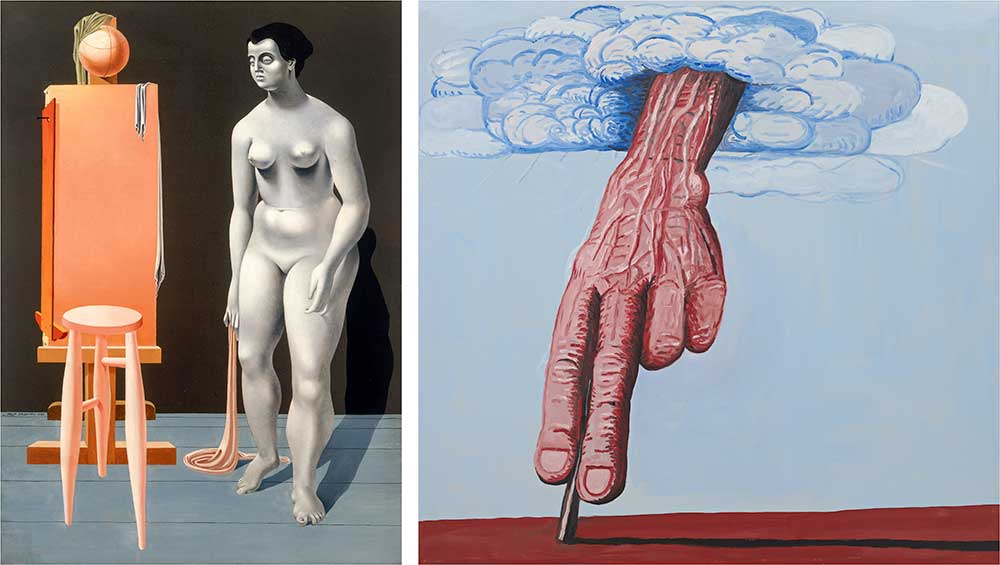
Philip Guston, Female Nude with Easel, 1935. Oil on canvas, 106.1 x 76.2 cm. Right: Philip Guston, The Line, 1978. Oil paint on canvas, 180.3 x 186.1 cm. Both images promised gift of Musa Guston Mayer to The Metropolitan Museum of Art, New York © The Estate of Philip Guston, courtesy Hauser & Wirth.
Tate Modern, London
5 October 2023 – 25 February 2024
by JOE LLOYD
In 1970, at New York’s Marlborough Gallery, the celebrated abstract expressionist Philip Guston (1913-80) revealed a new suite of works. Guston had set Manhattan alight in the 1950s with his agglomerations of coloured splotches, often in a palette dominated by greys, blues and pinks that resembled a James Ensor painting melted into gelatinous blobs. Throughout the early 60s, the colours drained out and his works became duskier and smudgier, but still defined by thick, tremulous lines, painted close to the canvas so that he would only himself see the overall composition at the end.
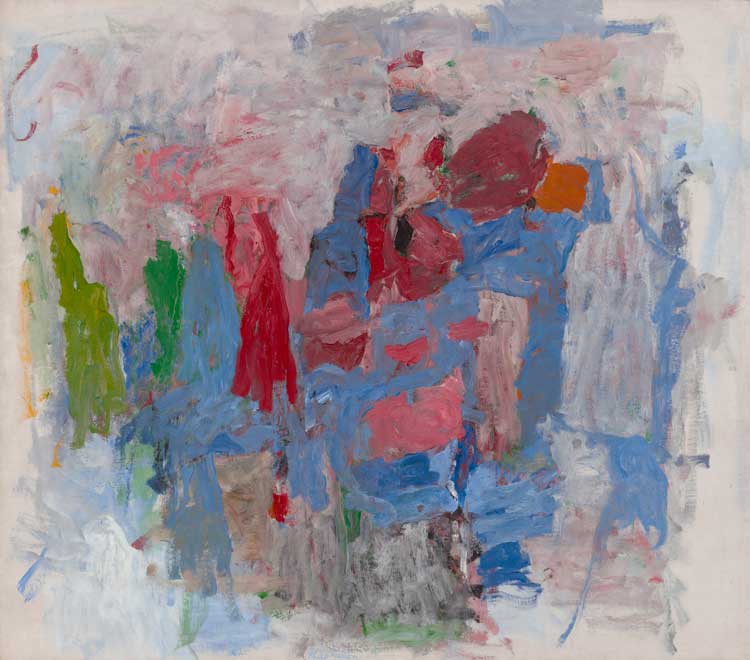
Philip Guston, Passage, 1957-8. Oil on canvas, 175.3 × 199.4 cm. The Museum of Fine Arts, Houston, Bequest of Caroline Wiess Law, 2004.20. © Estate of Estate of Philip Guston, courtesy Hauser & Wirth. Photograph © The Museum of Fine Arts, Houston; Will Michels.
In 1966, Guston burned out. He took a break from painting and focused on drawing. Eventually, a new style emerged. The Marlborough show was to be his return to the fold after a period of self-exile. A few friends knew what to expect. But when the show opened to reveal a new clumpy, fleshly figurative style, more R Crumb than Mark Rothko, it prompted an onslaught of criticism. The curator Michael Auping said: “This isn’t art.” Many of the works featured hooded figures modelled on the Ku Klux Klansmen, depicted as menacing but mundane, pot-bellied, pathetic incarnations of evil. Some roam the streets looking for trouble, some drive with a pile of legs in the boot. One sits smoking and bored, head leaning on hands, the embodiment of the banality of evil. But it was not the style or subject matter that stoked the most outrage, but the fact that the works had subject matter at all. As Robert Hughes wrote in Time: “Painting has become a clumsy way of reporting a society as turbulent and racked as this.” Photography and cinema had made painting an irrelevant mode of documentary. Painters should stick to trying to capture the ineffable.
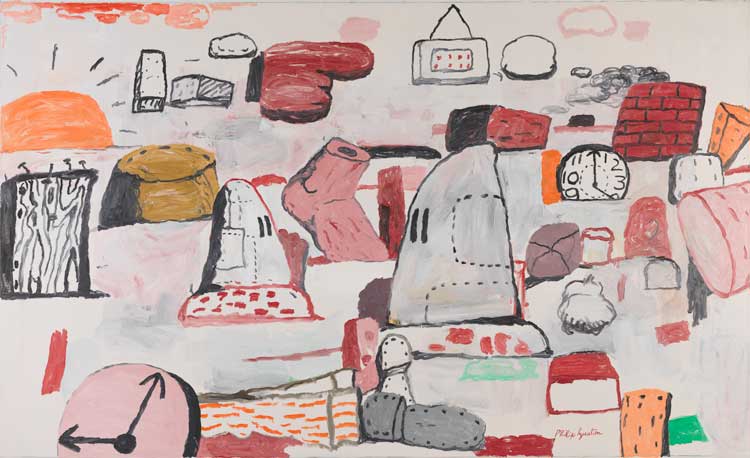
Philip Guston, Flatlands, 1970. Oil on canvas; 177.8 × 290.83 cm. San Francisco Museum of Modern Art, Gift of Byron R. Meyer. © The Estate of Philip Guston.
The critical tide would turn. Guston’s reputation steadily grew. He died months after a San Francisco retrospective that put his name firmly on the map. But in 2020, his 50-year-old paintings became the subject of controversy yet again. A retrospective that was to show in three American cities and London was postponed after the murder of George Floyd and the ensuing resurgence of the Black Lives Matter movement. Museum directors worried that the KKK paintings would trigger outrage. In response, hundreds of artists and curators signed an open letter accusing the museums of “lack[ing] faith in the intelligence of their audience”. A Tate curator was suspended for speaking out against the decision. But the postponement went ahead.
Now, three years on, the exhibition has finally reached Tate Modern. It was well worth the wait. Although the furore led to significant changes to the US versions of the show, the London edition neatly explains the political context early on, before casting itself as a straight-on exploration of Guston the painter. The decision has paid off. The exhibition leaves one in no doubt as to Guston’s status as one of the most exciting artists of his time. His startling works are encountered here with little mediation, except that from his own statements about his practice.
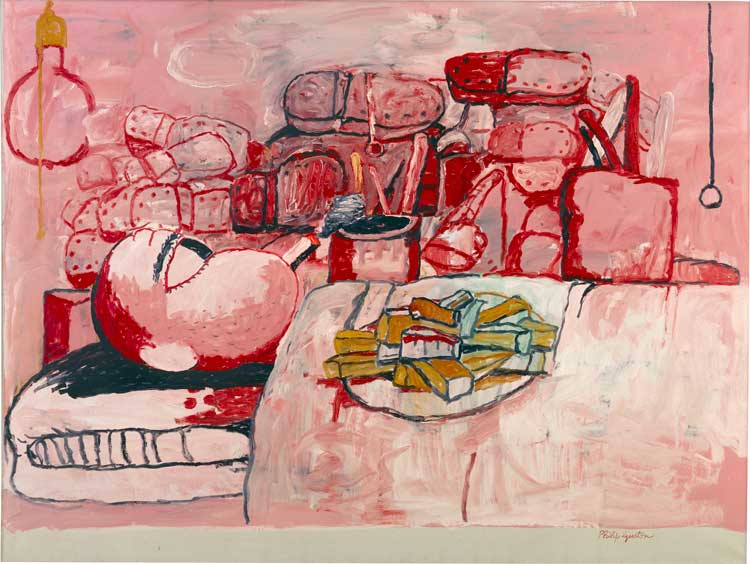
Philip Guston, Painting, Smoking, Eating, 1973. Oil on canvas, 196.9 × 262.9 cm. Stedelijk Museum, Amsterdam. © The Estate of Philip Guston, courtesy Hauser & Wirth.
We proceed almost chronologically, a decision that spotlights the full range of his work. Guston was born Philip Goldstein, in Montreal; he would change his name in the 1930s during a rising tide of antisemitism. Having fled persecution in Ukraine and come to Canada, his Jewish family moved to Los Angeles when he was a child. His father, a scrap collector, killed himself and his brother died after losing his legs in a car accident. As a teenager, Guston turned to drawing, devouring comic books and catalogues of Renaissance art. Along with his school friend Jackson Pollock, he became a keen follower of European modernism. His early works are a potpourri of influences. Female Nude with Easel (1935) and Nude Philosopher in Space-Time (1935) people the metaphysical world of Giorgio de Chirico.
Guston was politically engaged throughout his life. Drawing for Conspirators (c1930), executed when he was about 17, drew on the visual language of anti-lynching campaigns to depict the KKK committing an act of racial violence. As a teenager, he joined the Mexican muralist David Alfaro Siqueiros’s Bloc of Painters, which supported workers’ rights and protested against racism. He worked on numerous murals and frescoes in support of leftwing causes. In 1934, he and his friends Reuben Kadish and Jules Langsner painted a huge fresco for a university in Morelia, Mexico. The Struggle Against Terrorism, shown here by projection, combines poses of Michelangelo, the gargantuan bodies of Giulio Romano and the sacred architecture of Fra Angelico to startling effect. A Klansman appears as a ghoulish presence.
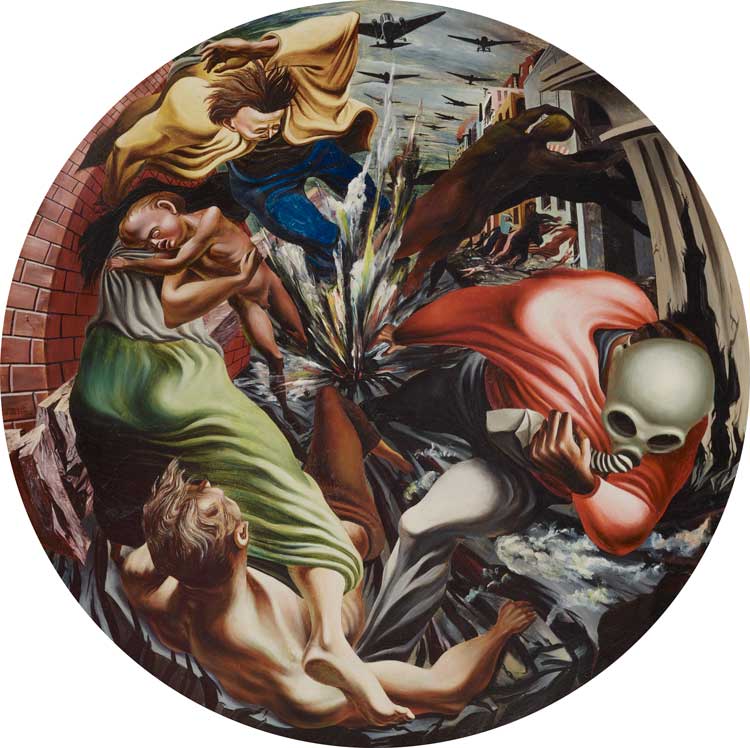
Philip Guston, Bombardment, 1937. Oil paint on paper, 106.7 cm. Philadelphia Museum of Art. © Estate of Philip Guston, courtesy Hauser & Wirth.
Guston moved to New York in 1936. As the Spanish civil war raged, his art exploded with disgust, dismay and righteous anger. Bombardment (1937) borrowed the tondo form of the Renaissance to capture the horror of aerial attack. A bomb explodes at the centre of the painting, creating a vortex that blasts people and objects to the side of the canvas. In the early 1940s, he created social realist depictions of the Queensbridge, the enormous housing project in Queens. Martial Memory (1941) features young children using kettles, bin lids and paper bonnets to play-act warriors. Is a tendency towards fighting latent within us? The unsettling If This Be Not I (1945), painted over the final year of the second world war, depicts eerie young creatures in makeshift crowns squatting over a pile of rubble.
The war, and in particular the images of concentration camps that began to circulate shortly after, led Guston to the first of two artistic crises. In the face of horror, plain depiction did not seem to cut it. In The Porch II (1947), he shows a band of agonised musicians playing beneath a black sky, a sinister rope stretching down to meet them. The same year, he started on The Tormentors (1947-48), a painting that stands on the knife-edge between figuration and abstraction. Boots, disembodied arms and the outlines of hooded figures – the same that had haunted him as a teenager and would haunt him 20 years later – are visible in a black and red field.
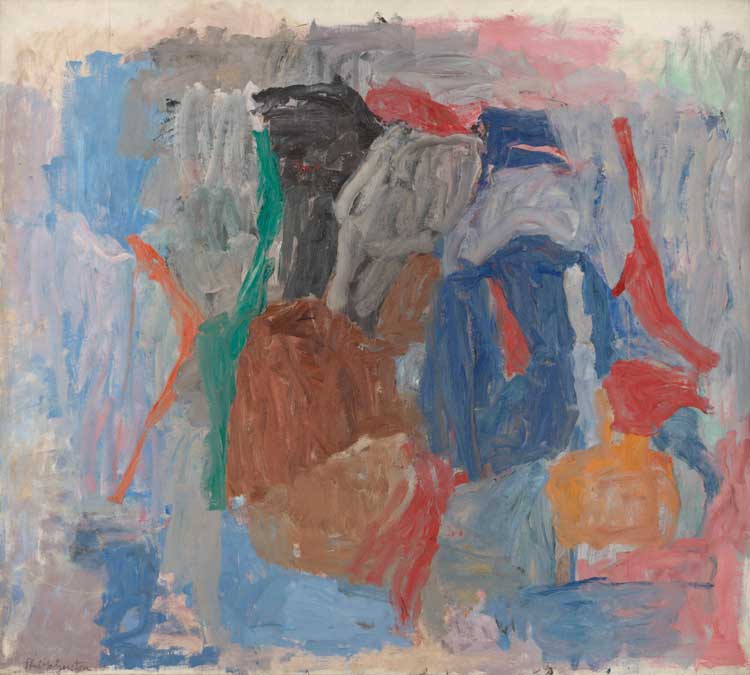
Philip Guston, The Return, 1956-8. Oil paint on canvas, 178 x 199 cm. Tate: Presented by the Friends of the Tate Gallery © Estate of Philip Guston.
The abstracts that followed, and made Guston’s name in the abstract expressionist flurry of the 50s, are very different. But they stand on a similar knife edge, with blobs of colour that could easily be objects or figures captured in a haze. The Return (1956-58) explicitly hints at a potential return to the figurative, while his darker work of the 60s often fixates on a head-like unit, sometimes attached to what could be a hulking body. Throughout, Guston uses an astonishing inventory of gestures. Beggar’s Joys (1954-55) is made of lines like short chubby fingers, while The Return’s strokes seem to zigzag back and forth like a coiling intestine.
After this triumph came burnout. And after that, a new mode of work. Although it represented an enormous rupture from the abstract orthodoxy, Guston’s return to figuration drew on all the painterly qualities of his previous mode. City (1969), which shows a series of stubby buildings piled up one after the other, part prison and part Tower of Babel, sits in a dense pink and grey cloud that could itself be an abstract expressionist painting. The strong painter’s line that Guston had developed was transformed into thick outlines. But the break was definitive. The KKK paintings seem to rebuke the vanity of abstract artists who felt themselves beyond politics. The Studio (1969) shows a hooded figure painting one of its own. Is the artist who does nothing to fight injustice equally culpable?
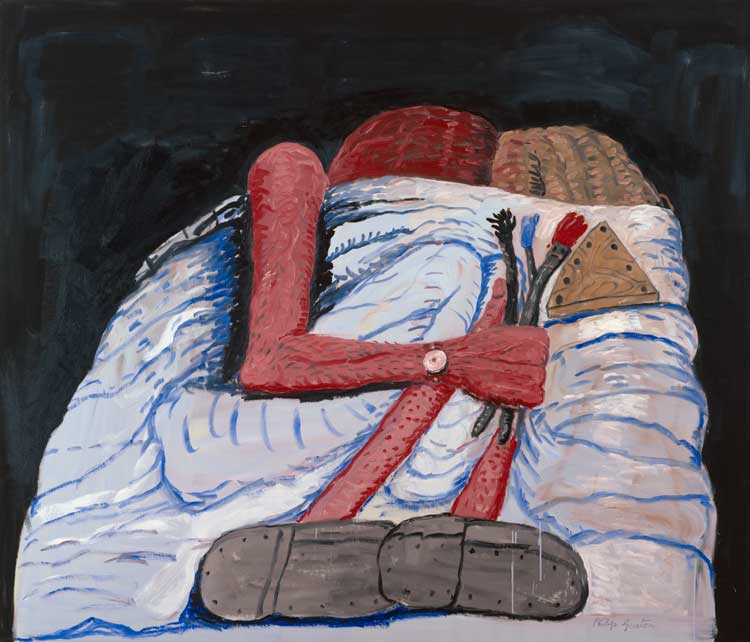
Philip Guston, Couple in Bed, 1977. Oil on canvas, 20.6 × 24 cm. The Art Institute of Chicago. © The Estate of Philip Guston, courtesy Hauser & Wirth.
Despite the initial outward glare of the hood works, however, Guston’s late works are remarkable in their unabashed self-interrogation. They often feature the artist himself, incarnated as a friendly cyclops and surrounded by a mishmash of objects that he described as “crapola”: broken glass, bin lids, shoes, bricks, arms and legs, empty bottles, coffee mugs, windows, some reflecting the mundane items of everyday life and some the threat of horrors. His surrealist bent from the mid-30s returns. Some are almost unbearably tender, such as Couple in Bed (1977). Here, the artist cuddles his wife, the poet Musa McKim, after she had suffered a succession of strokes. Works such as The Ladder (1978), where two impossibly proportioned legs hang on the eponymous object against a blue field that could be either wall or sea, see Guston play around with jokes and images.
Yet the tone is nightmarish as often as it is droll. Painter ’s Forms II (1978) stars a grotesque mouth disgorging legs. Monument (1976), in the same pink and grey as the abstracts, presents a horrifying pile of shoe-clad legs, a spider formed from severed limbs. It could reference Gaston’s brother Nat, whose legs were crushed in the car accident, or the catalytic evil of the Holocaust. The artist was never explicit. But a sinister shadow lurked. Kettle (1978) turns the household device into a brooding steam monster, slouching across a blood-red landscape. These are the Black Paintings of their time. And Guston is a painter for ours.
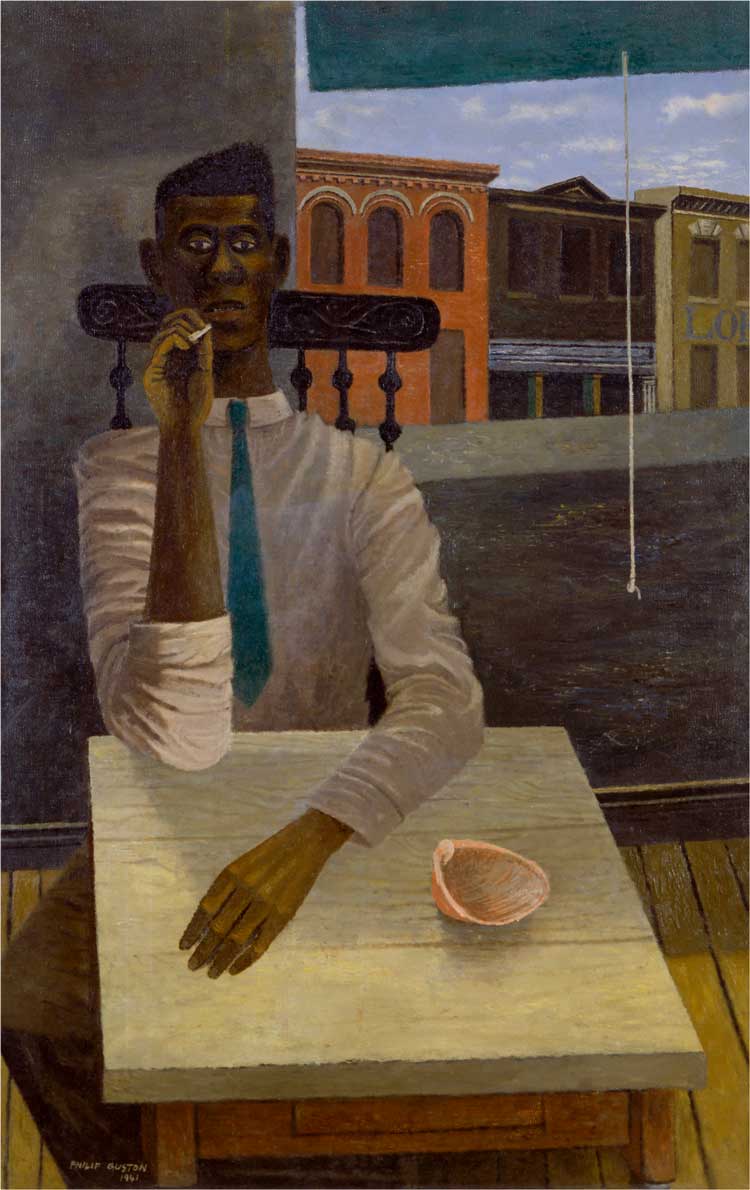
Philip Guston, Sunday Interior, 1941. Oil on canvas, 96.5 x 61.0 cm. Courtesy Private Collection © The Estate of Philip Guston, courtesy Hauser & Wirth.